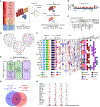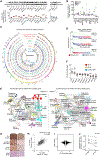Systematic multi-omics cell line profiling uncovers principles of Ewing sarcoma fusion oncogene-mediated gene regulation
- PMID: 36476851
- PMCID: PMC10333306
- DOI: 10.1016/j.celrep.2022.111761
Systematic multi-omics cell line profiling uncovers principles of Ewing sarcoma fusion oncogene-mediated gene regulation
Abstract
Ewing sarcoma (EwS) is characterized by EWSR1-ETS fusion transcription factors converting polymorphic GGAA microsatellites (mSats) into potent neo-enhancers. Although the paucity of additional mutations makes EwS a genuine model to study principles of cooperation between dominant fusion oncogenes and neo-enhancers, this is impeded by the limited number of well-characterized models. Here we present the Ewing Sarcoma Cell Line Atlas (ESCLA), comprising whole-genome, DNA methylation, transcriptome, proteome, and chromatin immunoprecipitation sequencing (ChIP-seq) data of 18 cell lines with inducible EWSR1-ETS knockdown. The ESCLA shows hundreds of EWSR1-ETS-targets, the nature of EWSR1-ETS-preferred GGAA mSats, and putative indirect modes of EWSR1-ETS-mediated gene regulation, converging in the duality of a specific but plastic EwS signature. We identify heterogeneously regulated EWSR1-ETS-targets as potential prognostic EwS biomarkers. Our freely available ESCLA (http://r2platform.com/escla/) is a rich resource for EwS research and highlights the power of comprehensive datasets to unravel principles of heterogeneous gene regulation by chimeric transcription factors.
Keywords: CP: Cancer; ChiP-seq; EWSR1-ERG; EWSR1-ETS; EWSR1-FLI1; Ewing sarcoma; enhancer; microsatellites; multi-omics; pediatric sarcoma; tumor heterogeneity.
Copyright © 2022 The Author(s). Published by Elsevier Inc. All rights reserved.
Conflict of interest statement
Declaration of interests The authors declare no competing interests.
Figures




References
Publication types
MeSH terms
Substances
Grants and funding
LinkOut - more resources
Full Text Sources
Molecular Biology Databases
Research Materials
Miscellaneous

